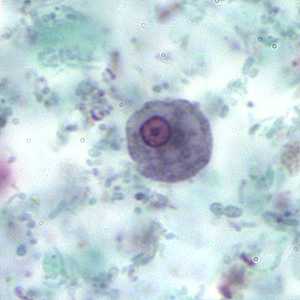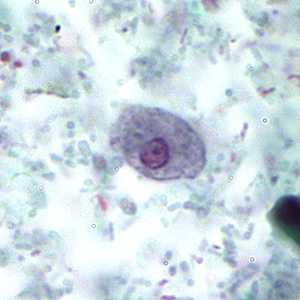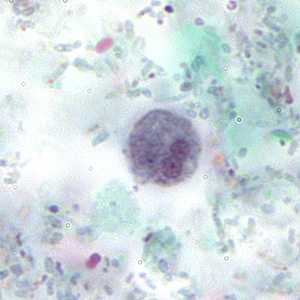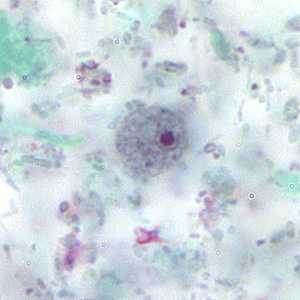
Case #167 - November, 2005
A 45-year-old woman went to her physician with complaints of recurring abdominal cramping, bloating, and infrequent diarrhea. Her travel history included a 10-day camping trip in Alaska, and her symptoms had started approximately 2 weeks after her return. Her physician ordered an ova and parasites (O & P) examination. Figures A-D show objects observed on a trichrome stained fecal smear; A-C were found in moderate numbers on the smear, while D was found in very few numbers. The objects shown ranged in size from 5 to 7 micrometers. What is your diagnosis? Based on what criteria?

Figure A

Figure B

Figure C

Figure D
Case Answer
The organisms identified in this case were Entamoeba hartmanni and Endolimax nana. These amoebae are generally considered to be nonpathogenic. Diagnostic features included:
- trophozoites of E. hartmanni (Figures A and B). The morphology of E. hartmanni is very similar to that of Entamoeba histolytica; both have a compact, centrally located nuclear karyosome, uniform distribution of peripheral chromatin, and fine, granular cytoplasm. Size of the trophozoites is consistent with the range for E. hartmanni (5 to 12 micrometers, averaging 8 to 10).
- a cyst of E. hartmanni (Figure C) with only two nuclei; mature cysts have four nuclei. The number of nuclei is also similar to E. histolytica cysts, but size of the cyst is consistent with E. hartmanni (5 to 10 micrometers) and distinguishes it from E. histolytica.
- a trophozoite of Endolimax nana (Figure D). The size range for E. nana trophozoites is 6 to 12 micrometers. The karyosome is generally large and red (when stained with trichrome). The cytoplasm is coarsely granular and can be very vacuolated.
More on: Nonpathogenic Amoebae
Images presented in the monthly case studies are from specimens submitted for diagnosis or archiving. On rare occasions, clinical histories given may be partly fictitious.
DPDx is an education resource designed for health professionals and laboratory scientists. For an overview including prevention and control visit www.cdc.gov/parasites/.
- Page last reviewed: August 24, 2016
- Page last updated: August 24, 2016
- Content source:
- Global Health – Division of Parasitic Diseases and Malaria
- Notice: Linking to a non-federal site does not constitute an endorsement by HHS, CDC or any of its employees of the sponsors or the information and products presented on the site.
- Maintained By:


 ShareCompartir
ShareCompartir